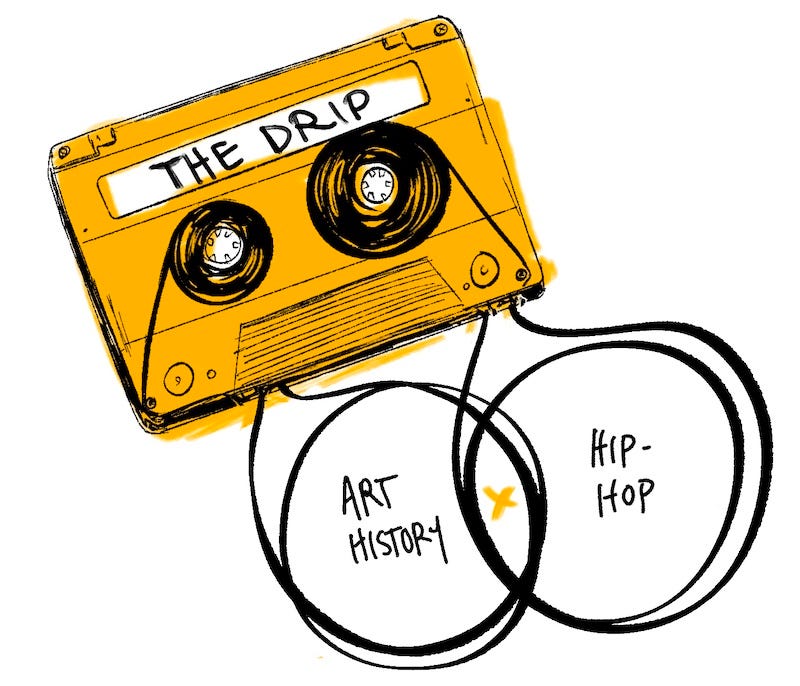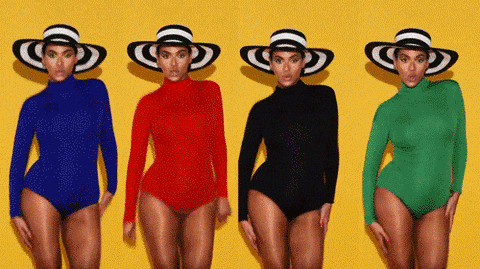
Mic check 1,2…
Welcome to the inaugural drop of The Drip, a newsletter that explores the sweet, gooey intersection of hip hop and art history. Like a mixtape and a sketchbook, this is an experimental space where raw ideas draw their first breath. (And maybe their last breath too!) At its core, The Drip is about finding perspective through intersections and listening to overlapping thought bubbles. Imagination blooms from these messy, undefined realms. Creativity sparks from finding patterns across disparate things. As an art teacher during the pandemic, I often thought about the connections my students and I could make across human expression to imagine greater possibilities in our own lives. This project was born from the classroom, and I’m writing as a lifelong student of hip hop and art—two things that bring so much joy and meaning to my life. Each month, I’ll choose a concept and break it down through weekly essays that bridge hip hop and art history. Think of the month as the mixtape and each week as a track. Hit it.
Vol. 01: The Case for Alter Egos
I’ll be honest. This first track is about alter egos because I realize I need to cultivate one for the internet. I’m not sure exactly how to do this, but I’m using the best technique I know to start off: a seayoncé.
A seayoncé is a ritual where you invoke the spirit of Beyoncé before attempting anything requiring a delusional amount of confidence. There are many ways to approach this. I’ll walk you through mine:
Take a deep breath.
Select a song. Right now, I keep it to a tight three: “Countdown” from 4, “Crazy in Love” from Homecoming: The Live Album, or “Lift Off” from Watch the Throne, which I will argue is canon.
Surrender yourself to a frenetic, full-body shake. No actual dance moves required, just vibes.
Unfurl the yoga mat (bath mat will do it too) and get down into camel pose. For a more expedited result, happy baby.
When your heartbeat is the only beat, invite Queen B to possess you–mind, body (booty?), and soul. Rinse and repeat until you’re ready to do the damn thing.
From job interview prep to risky texts, I know a lot of us practice some kind of hype rite that allows us to call upon the fiercest part of ourselves when we need it most. Beyoncé herself created an alter ego, Sasha Fierce, who helped subvert her shyness in order to summon the ferocious performer within. The way I imagine it, Sasha Fierce is like Athena, a god born from a god, who burst into existence decked out in full armor, ready to f*#$ing rage.
I have held multiple seayoncés in the process of launching this newsletter as a way to psych myself up when I start psyching myself out. As an artist, I feel the most tension when considering how much of myself to reveal in my work. I know that vulnerability is that sweet, golden goodness for which we risk getting stung. But it’s a constant struggle for balance. To create, you need safety, to share, you need to let go of it. I find some resolution when letting curiosity and fear guide me in the way I pursue and offer ideas. I’ll do my best to do that here.
While the idea of creating my own alter ego feels very appealing to me right now, I want to dig into that tension of vulnerability, between self-protection and self-projection. So for The Drip Vol. 01, let’s consider the case for alter egos. How can transforming into someone else reveal more of who you are?
I remember a trend in the early to mid-aughts when recording artists released albums under different personas. Some opted for subtle, sometimes imperceivable differences, like Janet Jackson’s 2004 album, Damita Jo. Others embraced dramatic changes in name, styling, and sound. My favorite example of this kind of drastic overhaul was country music star Garth Brooks’ alter ego, an Australian rocker named Chris Gaines. (The one thing that remained consistent across both performers? The soul patch.) The success of these alter ego albums varied. Some tanked, some invigorated careers for a promotional cycle. More times than not however, it seemed like a contrived way to satisfy the age-old record label expectation for artists—particularly women artists— to reinvent themselves with each new album.

While alter egos may come off as gimmicky in this context, artists have long employed the alter ego across disciplines to explore and experiment with different aspects of identity. From culture and gender, to memoir and mythology, the alter ego is ultimately a liberator. There is a freedom in expressing yourself, fully present in your mind and body, but impervious to true judgment. The alter ego allows for the separation of self in that it puts vulnerability under a glass case. You can perceive it from the outside, but it remains untouchable. Superman’s alter ego Clark Kent transforms in a phone booth of all places, a metaphor for clear visibility but boundaries around accessibility.
In hip hop, it’s hard to find an MC who doesn’t have at least one other moniker, persona, or fully formed alter ego. This phenomenon transcends industry marketing schemes and originates from a desire to include more voices in the stories they tell. Alter egos act as family, foils, and villains, allowing for different personalities to push conversations and contribute to the worldbuilding within an album, a career, and even into the mythology of the artist. The person who did this most extensively and successfully, I argue, is MF DOOM, also known as “your favorite rapper’s favorite rapper.” MF DOOM was a hip hop legend shrouded in mystery. As a prolific underground MC, he created several alter ego characters, all collaborators he wove into his sonic graphic novels. Rest in beats.
Looking back into art history, I’m fascinated by artist alter egos who pushed ideas around authenticity and the expectations projected onto art itself. In addition to MF DOOM, I’m bringing in Marcel Duchamp, Theaster Gates, Tracey Emin, and other artists who flip the script on identity practice and performance into the intersection.
I’m going to end with something I could have begun with–the definition of alter ego. In Latin, it’s translated as “the other I.” Roman philosopher and politician Cicero is the first person documented to write about the alter ego, describing it as “the second self, a trusted friend.” Cuuuuute. While alter egos project out a separate persona, I think they are truly meant to guide an internal shift in how we think about ourselves. As we marinate on this topic this month, I want to remind us of Cicero’s definition, a trusted friend. I’m running with that for my alter ego. Grab your sneakers if you’re down, and meet me in the middle.
Thanks for reading.
p.s. The Drip drops every Thursday, with some hidden tracks sprinkled in from time to time. See you next week!








I am obsessed with this. Can't wait to read more.
This is fantastic, and it makes me so happy to see it live!